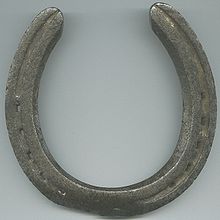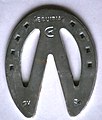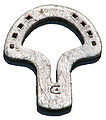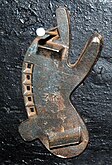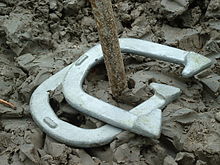horseshoe
A horseshoe is a mostly U-shaped iron with nail holes, which is attached to hoofed animals by a farrier to protect their hooves by nailing , also known as shod . The hoof can also be protected by so-called hoof shoes .
history

Even in ancient times , people were looking for protection for their hooves, which are heavily worn down from hard, stony ground. Especially with the military use of the horse, hoof protection became a necessity, because during war the horses were stressed beyond their natural limits.
So-called hippo sandals are ancient forerunners of today's hoof boots for horses. In ancient Egypt , woven raffia sandals or leather shoes were used that were tied to the horse's leg with cords or straps. However, such constructions were not very durable. The Romans already used a hoof protector made of bronze or iron tied with leather straps, but here too the straps must have caused abrasion wounds. Contemporary sources report gold and silver hippo sandals for favorite horses of the imperial family and hoof boots for mules on mule tracks . The heavy, tethered irons were not suitable for fast riding, as they often fell off at higher gaits and, with their iron soles, offered little grip. Some had studs for better grip on muddy or soft ground.
Nailed horseshoes, as used to this day, appear to have been invented by the Celts. In use since the late Celtic period (2nd or 1st century BC), they were adopted and modified by the Romans. The finds of nailed horseshoes only became more numerous around 600. Despite individual ancient evidence, many historians therefore date the invention of the nailed horseshoe further into the early Middle Ages .
As a further indication of the dating of nailed horseshoes in antiquity, Neupotz's hoard is often given. The current interpretation of the find complex regards it as the booty of a returning Alemannic raid that was lost in 260 . Since pre-Roman and post-ancient finds also came to light during the salvage, the found horseshoes cannot be clearly identified as Roman.
Shapes and sizes
There are rebate shoes that have a longitudinal groove called a rebate with holes for the horseshoe nails. A continuous fold serves as a basic slide protection. Hoof nails with a rectangular head are used for folding irons, with the narrow edge fitting exactly into the fold.
Stamp shoes , on the other hand, have no fold. The name comes from the stamp with which the holes for the horseshoe nails are driven. For stamping iron, horseshoe nails with a square head are used. Since stamping irons have no profile, they slide better. Wide, smooth and therefore particularly slippery stamp shoes are suitable for the sliding stop when cleaning .
Due to the different functions of the horse's fore and hind limbs, the hooves of the fore quarters have a circular shape and the hooves of the hindquarters have a pointed shape. The horseshoes are shaped accordingly.
On the front legs, iron with a toe lift ( toe cap ) is usually used. An elevator is a flat piece of iron that is pulled up in the form of a leaf at the outer edge of the horseshoe ( pulling the cap ). The front toe tip of the hoof is rasped away a little so that the lift is flush. The lift gives the iron a better hold on the hoof. A central lift does not affect the hoof mechanism. In racing, toe-wound irons are used to speed up rolling. There are several patented variants of the toe cap.
Horseshoes with two side lifts ( side caps ) are mostly used on the hind legs . The two side lifts allow the iron to be moved back a little and the risk of the horse pulling off the front iron with the rear hoof is lower. A two-lift iron sits more firmly on the hoof and is particularly suitable when the hoof is brittle or parts of the hoof have broken off. However, the two side elevators interfere with the hoof mechanism.
The size can be specified in length × width in millimeters. The size selection ranges from 8 × 0 to 16 for cold blooded animals . It should be noted that the size specifications vary in length / width dimensions and the shape of the horseshoe, depending on the horseshoe manufacturer.
material
The classic horseshoe material is “iron” ( steel ), but materials or material alloys made of aluminum and copper are also used. Today, different plastics are often used. These are then partially also glued on.
- Steel : The most common material for horseshoes nowadays is resistant steel.
- Aluminum : Since aluminum has a much lower density than steel, it is often used in racehorses to save weight. Since aluminum is a very soft metal, the light metal horseshoes wear out faster than those made of steel.
- Plastic : In addition to its lower density, plastic is also characterized by a certain elasticity. This is intended to dampen the impact when the horse's hoof hits the feet and protect the joints.
- Aluminum with steel : In order to prevent premature wear of the horseshoe and thus increase its service life, "aluminum irons" with so-called steel handles in the toe fold are often used.
- Plastic with steel : Since the plastic wears out very quickly due to its softness on the one hand, parts of the horseshoe or the entire core are reinforced with steel.
stollen
Studs give the horse more traction in poor ground conditions. They are used in jumping and cross-country equestrian sports to give the horse the necessary support during jumps, but also in the course. In winter they are used so that the horse can break up any layers of ice with them and not slip on them.
There are welded studs, plug-in studs, screw studs and forged-on studs, in English Calkins . Horses pulling heavily on hard ground wear their toes excessively, for them a rectangular piece of metal called a "handle" can be attached to the tip of the iron. In winter, the forged studs and the handle can also be sharpened for better traction ("ice handle").
To attach screw studs, holes must be drilled in the horseshoe at both ends and threads made in these. The studs are then screwed into these holes with the help of a stud wrench. Plug-in studs are simply driven into the stud holes. Studs are available in different sizes, widths and shapes, which can be selected according to the existing soil conditions. There are, for example, square tunnels, long tunnels, conical tunnels, H-tunnels, pointed tunnels, turf tunnels and mud tunnels. The disadvantage of cleats is the risk of injury, both self-injury ( crown kick , cleats bumps ) and for other horses in knocking out the cleated horse. Studs impair the gliding phase of the hoof when stepping on. The hoof is stopped immediately when stepping on, which leads to increased stress on tendons and joints.
equipment
- Widia pins : holes must be drilled in the horseshoe for these small metal pins too. Due to their conical shape, they do not need a thread, but are simply knocked into the iron. Widia pins are usually attached to the ends of the legs so that each iron has two Widia pins.
- Since the Widia pins do not protrude so far out of the horseshoe and have rounded edges, they provide extended support in poor ground conditions or on asphalt, but do not pose any risk of injury to other horses in the paddock and influence the position of the hoof to the ground even on hard ground not essential. Pins also significantly reduce the wear and tear of iron and nails on asphalt, pavement and gravel roads, but put more stress on the joints because the footed hoof can turn more poorly.
- Eisnägel : Horseshoe nails with a Widia pin integrated in the head . As a result, the nail heads grip on ice and generally wear out less, but sharp and dangerous edges / points can arise due to wear and tear on the surrounding steel.
- Soles and insoles : Leather, plastic, rubber, felt or aluminum is placed between the hoof and the horseshoe, for example to protect the sole or the frog or to support healing. You can also use padding made of silicone, Hebaform, wadding or hemp.
- Snow grip ( hoof grip ): Rubber inserts that are placed between the hoof and the horseshoe when the horseshoe is nailed on. They prevent so-called studs from forming in the hooves in winter . When the horse steps into damp snow, the snow under the hoof is compressed into a firm lump of ice, also called a snow tunnel, which often sticks to the horseshoe. With every step, the studs get thicker until they eventually fall off. This means that the horse has studs of different thicknesses on the hooves. It can only limp, like a woman with a broken heel and easily slipping on the lump of ice. The hollow rubber bead of the hoof grip moves with every step, causing the snow cleats that keep forming to fall out of the hoof. The formation of lugs can also be reduced somewhat with a leather sole.
Special horseshoes
There are also special horseshoes for special requirements on the horse or hoof:
- Army horseshoe : Compared to the normal horseshoe, an army horseshoe has a higher number of nail holes in a horseshoe shank. Whereby no more horseshoe nails are used than with a normal shoe. The point here is to create enough opportunities for a horseshoe that may be badly directed under field conditions to nail into the white line. Army horseshoes can also have 4 threaded holes for screwing in square metal studs.
- Open toe horseshoe ("inverted iron"): A conventional, matching horseshoe is nailed upside down (open side under the toe). This enables horses with long toes ("acute-angled hoof") to wear them more while at the same time protecting their heels.
- Closed horseshoes (round irons) are often used to prevent the hoof from being worn too much on the ball of the foot. They are also used to correct the hoof or reduce conditions such as B. Spat used.
- Half-moon iron : The horseshoe lacks the rear legs (rods) and is therefore only nailed under the toe. This enables horses with a buck hoof to wear their heels more and to protect the toe horn.
- Three-quarter horseshoe : horseshoes with a shortened leg to protect one of the heels
- Wedge iron : The thighs become higher from the tip of the toe to the rear end. These irons are often used to correct posture or for diseases such as B. Spat .
- Oval iron ( egg bar , Ringeisen , Heart Bar Shoe ): Provides greater contact surface.
- Bar : The horseshoe is closed at the back and this bar also extends to the inside of the bar under the beam. This bridge thus absorbs part of the forces acting and the heels are relieved.
- Navicular iron : The thigh ends of this horseshoe are thickened, which reduces the pressure of the coffin flexor tendons on the navicular bone.
- Heart Iron : Iron intended to support the beam.
- Iron : Instead of a bridge, a bracket is attached.
- Slipper iron : The legs of this horseshoe are raised on the inside so that there is an outward sloping angle. This horseshoe shape is used when traditional costume is compulsory to prevent further contraction and rather to support expansion.
- Mushroom iron: Mushroom-shaped iron in which the "stem of the mushroom" rests on the beam and thus relieves the corner struts.
- Hikers' iron : The horseshoe is greatly widened on one side or even halved in the vertical. This shoe is used on horses that put a lot of strain on one side of the hoof and therefore wear out a lot. The worn side should be protected more by the special iron.
- Broad-thigh horseshoe (after Lungwitz) :
- Broad-thigh horseshoe (according to Bauer) :
- Sliding iron : The legs of this horseshoe shape are open to the rear and elongated and guarantee the horse that the heels are protected while sliding and cause an extension of the glide path. In addition, they are processed very smoothly and without a fold to promote sliding.
- NBS ( Natural Balance Shoes ) horseshoes: The toe curve of the horseshoe is a little flattened and reinforced. This will move the roll-off point back. This fitting is often used in show jumping.
Claw iron
Cattle (driving cows) and oxen (draft ox) used as work animals are usually given claw irons, which were usually put on cold, i.e. had to be pre-worked precisely.
- Claw iron in draft cattle
additional
Lucky symbol and superstition
In popular belief, iron in general and the shape of the horseshoe in particular are said to have magical powers. It makes invulnerable, protects against evil spirits and can ward off natural disasters. This view may have been promoted by the earlier high price of iron. Horseshoes were and will be attached over doors, entrances, chimneys, on ship masts, etc. During the height of the witch craze in the European Middle Ages, it was believed that witches soared through the air on brooms because they were afraid of horses. Any memory of a horse would therefore be as effective at deterring witches as garlic would be a vampire . To prevent the resurrection, a horseshoe was placed on the lid of the coffin of executed witches. Even in popular Islamic beliefs, the horseshoe was ascribed a disastrous or auspicious power in some places. In the Maghreb , for example, a horseshoe hung over the front door should protect against the evil eye .
There is no agreement on how a horseshoe should be hung. With the opening at the top, it could represent the devil's horns. It can also stand for a well or a gate through which happiness can enter. That is why you shouldn't hang it with the opening facing down ( otherwise happiness will fall out ). According to another interpretation, this is exactly what is necessary. The horseshoe must be hung with the opening facing down so that happiness can flow out to you. In addition, the horseshoe was hung "protectively over the house" because it was believed that neither the devil nor evil spirits could pass under an arch of iron. In the same way, lightning strikes should be prevented, because in rural areas it was also considered lucky to survive a thunderstorm unscathed. There are two irons above some doors, one with the opening facing down and one with the opening facing up. A third option is to hang it with the opening to the right. In this case it symbolizes a "C" for Christ .
A found horseshoe was recently considered a good luck charm , especially if it still had at least three nails. However, the prerequisites were that you had found it and not looked for it and hung it with the opening facing up.
Horseshoe game
This throwing game is mostly played outside. It is important to throw the horseshoe in such a way that it wraps around a free-standing stick or is closer to it than the opponent's throw. Rule of the game: looping around the bar counts 3 points, the iron closest to the bar 2 points, and the next 1 point.
See also
literature
- Otto Brose: On the history of horseshoeing. Berlin 1925.
- Germain Carnat: The horseshoe in its meaning for culture and civilization. Zurich 1953.
- Urs Imhof: The history of shoeing. In: Swiss Archives for Veterinary Medicine 152, 2010, 21–29 (full text) (PDF; 921 kB).
Web links
Individual evidence
- ↑ Rupert Gietl: The Romans on the passes of the Eastern Alps , Vienna 2004, p. 27 ( PDF )
- ↑ The Roman Tauern Road - the section Pass Lueg to Iuvavum , Raimund Kastler, Roman rest stops and road infrastructure in the Eastern Alps, Innsbruck 2010
- ↑ Peter Connolly : The Roman Army. Translated from the English by Thomas M. Höpfner. Tessloff , Hamburg 1976, ISBN 3-7886-0180-9 , p. 61 (“Horseshoe”).
- ↑ Naming of the horseshoe parts (PDF), FU Berlin.
- ^ Patent for toe caps from 1980
- ↑ Patent for horseshoes with toe lift from 1984
- ↑ Brockhaus Konversationslexikon, Volume 5, 1902, keyword "Horseshoe"
- ↑ Claw fitting at Zugrinder.de , accessed on November 15, 2019
- ↑ Why should horseshoes bring luck?
- ↑ Ignaz Goldziher : Iron as protection against demons. In: Albrecht Dieterich (Ed.): Archive for Religious Studies combined with the contributions to the Society for Religious Studies in Stockholm. Volume 10, BG Teubner, Leipzig 1907, pp. 41–46, here p. 45
- ↑ Find a lucky charm
- ↑ The importance of the horseshoe as a good luck charm

